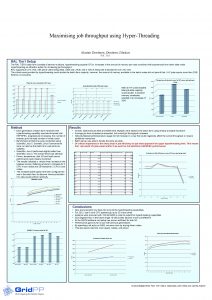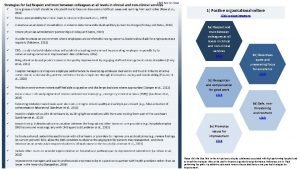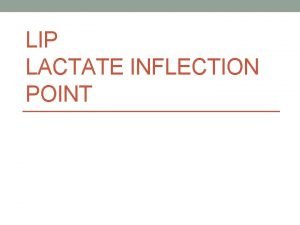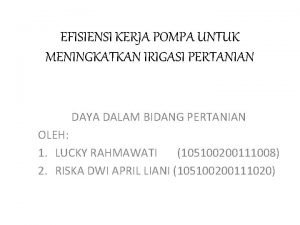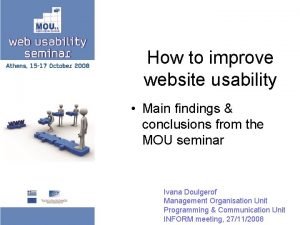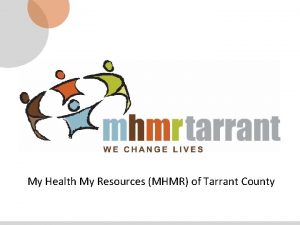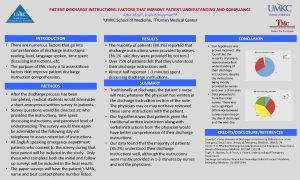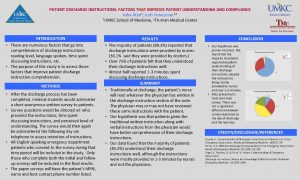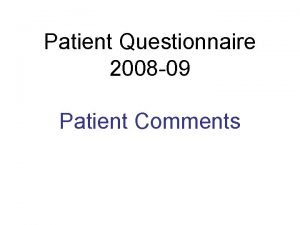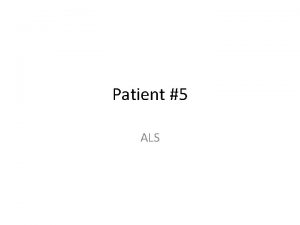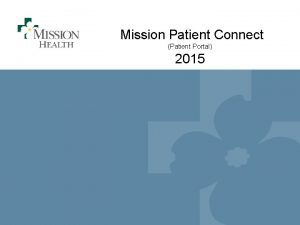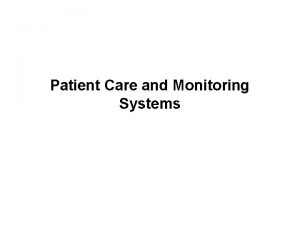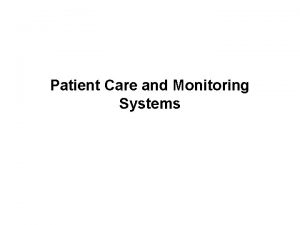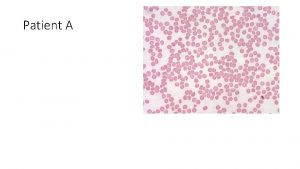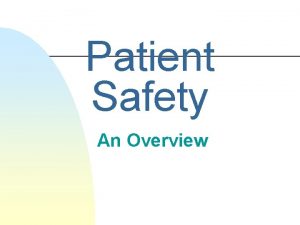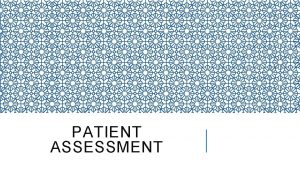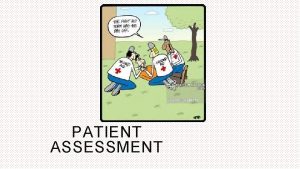Strategies to Improve Patient Retention Experiences from Grantees































































- Slides: 63

Strategies to Improve Patient Retention: Experiences from Grantees Aug 25, 2008 Johanna Buck, RN NYSDOH AIDS Institute Senior QI Consultant Margaret Palumbo, MPH HIVQUAL Consultant Panel: Tammy Derden, MBA, BS Ed, CHES, Jeff Curtis, MS Funded by HRSA HIV/AIDS Bureau

Overview • Introduction • Measurement • Quality improvement and retention • Strategies and conclusions 2 National Quality Center (NQC)

Why is Retention Important? • Medical Care § The heart of the patient-provider relationship; “medical home” • The Primary Care Model § Access § Coordination § Continuity § Comprehensiveness § Quality 3 National Quality Center (NQC)

Why is Retention Important? • Public Health § Retention likely to help prevent and control chronic disease, reduce morbidity and premature mortality leading to improved population health 4 National Quality Center (NQC)

Retention and Outcomes: The Evidence Base for HIV • Multiple studies demonstrate that patients who are retained in care have better likelihood of viral load suppression • Conversely, patients who miss appointments frequently are more likely to have virologic failure • Patients who miss visits have longer hospital stays and use emergency services more 5 National Quality Center (NQC)

Continuum Engagement in Care Not in Care Unaware of HIV Status (not tested or never received results) Fully Engaged Know HIV Status (not referred to care; didn’t keep referral) May Be Receiving Other Medical Care But Not HIV Care Entered HIV Primary Medical Care But Dropped Out (lost to followup) Non-engager In and Out of HIV Care or Infrequent User Sporadic User Fully Engaged in HIV Primary Medical Care Fully Engaged Health Resources Service Administration (HRSA) 6 National Quality Center (NQC)

Approaching Retention from a QI Perspective • Perfectly suited to system-level interventions and quality improvement § Measurable § Improvable § Team-based approach § Multiple processes: system § Patient-centered 7 National Quality Center (NQC)

Measurement • What is the extent of the problem? § No-shows § Retention rates 8 National Quality Center (NQC)

No-Show Rates: aka “DNKA” • No-show rates range from 25% to >40% in published studies • Limitations: § Patients may be counted for multiple visits § Type of clinic visit not uniform § Time frame accepted for prior cancellation § Rescheduling: does it count? § What about walk-ins/open access? 9 National Quality Center (NQC)

Retention Rates • Require precise definitions of expected number of visits during a specified time interval • Eligible population required for the denominator which requires determination of visit type and determination of active caseload of the clinic 10 National Quality Center (NQC)

Constructing a Retention Measure • Consider variations in practice standards regarding expected number of visits and interval between visits • Understand what contributes to practice standards at your clinic – e. g. , patient stability, geography • Define and test a measure that reflects the minimum standard for your practice 11 National Quality Center (NQC)

New York State Measure for Retention in Care Number of unique HIV-infected clients with at least 1 HIV primary care visit in each half of the calendar-month year Number of unique clients with at least 1 visit during the calendar year 12 National Quality Center (NQC)

Considerations in Implementing a Retention Measure • A basic retention measure alone provides a limited look at the important issue • Further investigation and analysis are usually required, for example § after determining baseline measurement, “look back” at the patients who did not meet the definition of being retained § the second measurement cycle will require identifying patients who were retained the first cycle but did not return for care during the second 13 National Quality Center (NQC)

Data Sources • Is the universe of patients captured in the available database? • Data sources are usually imperfect: Improving them is a top priority • Retention rates range from 70 -85% in NYS HIV clinics: Who is not retained? • Who is at risk for not being retained? 14 National Quality Center (NQC)

Why Don’t Patients Come? (From the Literature) • • • • • 15 Younger Age Education level Lack of insurance Lower income High CD 4 count No AIDS diagnosis History of IDU or current IDU Lower perceived social support Shorter interval between baseline visit Less engagement with provider Minority communities, particularly African-Americans Heterosexual patients Work conflict No transportation Family illness Forgetting Conflicts Feeling too ill Feeling well National Quality Center (NQC)

One NYC Hospital’s Experience • One-Visit Study – Queens General Hospital* § § Exclude those who moved, transferred or died 15 patients not “retained”: • Unable to contact 7 • Contacted 8: § § § 2 reported active substance abuse, 1 returned to care 1 fear of recognition, referred to other HIV clinic 1 psychiatric history, attends multiple HIV clinics 1 looking for a job, returned to care 1 refused outpatient treatment despite extensive outreach efforts (frequent QHC hospitalizations) 2 feeling well, are early in HIV and refused frequent medical visits Jazila Mantis, MD, Jean Fleischman, MD, Kathleen Aratoon, NP, Maria Szczupak, RPh, Diana Jefferson, RN, Terri Davis, MSW, Maria Bucellato 16 National Quality Center (NQC)

Keep the Balance… 17 National Quality Center (NQC)

Quality Improvement and Retention 18 National Quality Center (NQC)

Improving Retention • Understand the patient level and system level factors associated with retention in care • Look to the literature for evidence based strategies and decide whether they apply to your population • If they apply, test them in your population • Target improvement efforts 19 National Quality Center (NQC)

Improvement Strategies to Retain Patients in Care: Examples from the Field § Improve clinic operation & information systems § Obtain consumer involvement to identify barriers & solutions § Increase staff & patient awareness § Develop focused case management resources (internal & external) 20 National Quality Center (NQC)

Improvements: Current Status • Patient Factors § May or may not be amenable to change § Supportive services may be beneficial § Outreach programs effective but expensive • System Factors § Amenable to change § Do changes result in improvement? § QI methods well-suited to improving retention and testing strategies 21 National Quality Center (NQC)

Practical Strategies to Connect Patients to Care • Partnerships with community-based agencies offer great potential • Supportive services, including navigation and case management, help increase retention by removing barriers and meeting needs • Provider engagement and behavior affects levels of and retention and decrease sporadic use: fortify relationships Outreach Initiative: HRSA SPNS Multi-site Evaluation, 2007 22 National Quality Center (NQC)

Practical Strategies (2) • Use peers • Target new patients • Help patients access needed services to remove barriers to care: transportation, mental health support, drug treatment • Reduce drug use • Dispel negative health beliefs Outreach Initiative: HRSA SPNS Multi-site Evaluation, 2007 23 National Quality Center (NQC)

What can we do now? • Use a common measure • Identify proven strategies: Measure! • Focus efforts on those not fully engaged or not retained • Learn from patients • Learn from each other • Consider the context of your organization, patient population and community 24 National Quality Center (NQC)

Policy Issues • Looking beyond the clinic: § Patients may seek care from multiple providers § VAH, Corrections, NFs, Residential drug treatment, migrants, visitors • Services § Outreach § Maintenance in Care § Field Services Unit § List searching 25 National Quality Center (NQC)

Policy Issues • Responsibility of treating institution § Calls, letters, legal issues § Should certain patients be sought more than others? § What is a “reasonableness” standard? § When is the search “closed”? § “Whose patient is it anyways? ” 26 National Quality Center (NQC)

Way Forward • Coordination of clinical and non-clinical service agencies • Collaboration between city and state initiatives 27 National Quality Center (NQC)

Acknowledgements • Bruce Agins, MD, MPH • The New York City Health and Hospitals Corporation HIV Quality Learning Network • Margaret Palumbo • Elizabeth Horstmann • Phoebe Arde-Acquah 28 National Quality Center (NQC)

Grantee Example 1: Using Quality Improvement to Improve Patient Retention in HIV Care A Tri-State Regional Quality Group Approach (Ohio, WV, PA) 29 National Quality Center (NQC)

Background A Regional QI Workgroup of multiple Ryan White grantees under the sponsorship of the National HIVQUAL Project was initiated to reduce barriers to retention, track patients who drop out of care and share best practices of successful improvement strategies 30 National Quality Center (NQC)

Background • 9 Ryan White-funded grantees (10 service providers) in Southwest PA, Ohio and West Virginia • Caring for over 3, 000 patients; unduplicated patients in care ranges from 100 to 1200 • Variation in years of Ryan White funding (3 to 12) • Variation in QM experience and understanding • Variation in information systems sophistication and ability to collect and report data routinely 31 National Quality Center (NQC)

Project Aim • Reduce the number of patients with “unmet” need as defined by HAB: “Individuals who are living with HIV, are aware of their HIV+ status, but are not engaged in regular medical care” • Increase the number of patients who have connected to a medical provider and are seen for trimester medical monitoring visits • Share best practices across regional Part C/D grantees 32 National Quality Center (NQC)

Methods • Retention defined as patients seen in the last 4 months (trimester) • Each clinic developed mechanisms to produce case lists and track retention utilizing existing data systems (CAREWare, LABTRACKER, hospital billing) • Utilized standard QI methodology 33 National Quality Center (NQC)

Standard Measure • All patients will be seen by a medical provider every 4 months (trimester) • Denominator: Number of unique patients in care • Numerator: Number of unique patients seen 1 x in last 4 months • Adjusted for patients who have expired, currently incarcerated, relocated or changed provider 34 National Quality Center (NQC)

Reasons identified for patients not being seen every trimester • • • 35 Active Mental Illness Active Substance abuse Transportation Unstable Housing Too sick to keep appt If well, may not perceive appointments as necessary Lack of family and other social supports Inflexible working schedules Inflexible clinic appointment schedules Incarceration Lack of “connection” to medical provider Fear of disappointing medical provider if not adherent to tx National Quality Center (NQC)

Retention in Care – Baseline Data 36 National Quality Center (NQC)

Improvement Intervention Examples • Perform aggressive follow-up for patients who miss appointments • Use of peer advocates to support retention • Provide flexible appointment schedules including more access to walk-ins and evening appointments • Assure early identification of patients at high risk for dropping out of care, i. e. , active substance use, unstable housing and link to more intensive individualized support services (peer advocate/case manager) 37 National Quality Center (NQC)

Improvement Intervention Examples (continued) • Target individuals with more acute illness and greatest needs, specifically those on HAART with detectable viral load levels • Improve continuity between research and treatment programs • Initiate Case conferencing with focus on those patients at risk for dropping out of care • Provide targeted patient education • Improve clinic efficiency/reduce wait times • Offer more evening appointments 38 National Quality Center (NQC)

Follow-up Results MEDIAN: 82. 5%, AVERAGE: 82, LOW: 64, HIGH: 95 39 National Quality Center (NQC)

Summary of Group Results • Initial retention rates ranged from 68% to 90% • After one year 7 of 10 sites (70%) showed improvement in retention rates ranging from 1 to 6% from baseline • 3 sites showed no improvement in overall retention • Sites with no improvement identified problems with data retrieval and lack of sufficient time to fully implement improvement strategies • All sites applied CQI methodology to address retention 40 National Quality Center (NQC)

Summary of Group Results (cont. ) • Limited resources calls for good understanding of which interventions are most effective BUT • In the case of retention it is difficult to assess which intervention has the greatest impact • Group felt a “package” of interventions was important 41 National Quality Center (NQC)

Lessons Learned • Know your patients, know your data, so that you don’t go down the wrong path • Don’t ignore your hunches but try to test your interventions before full implementation 42 National Quality Center (NQC)

Participating Organizations • • • 43 Allegheny General Positive Health Clinic, Pittsburgh, PA Community Health Net, Erie, PA Clarion University, Clarion, PA West Virginia University, Morgantown, WV Charleston Area Medical Center, Charleston, WV Case Western University, Cleveland, OH Comprehensive Care Clinic, Youngstown, OH University of Pittsburgh, PA Columbus AIDS Task Force, Columbus, OH Nationwide Childrens Hospital, OH National Quality Center (NQC)

Grantee Example 2: FACES PROGRAM (FAMILY AIDS CLINIC EDUCATIONAL SERVICES) Columbus, Ohio Tammy Derden, MBA, BS Ed, CHES Quality Management Coordinator/Database Manager Tammy. Derden@nationwidechildrens. org 44 National Quality Center (NQC)

FACES PROGRAM FAMILY AIDS CLINIC EDUCATIONAL SERVICES I. Overview of FACES PROGRAM II. Retention Project A. Group Focus- New Patients B. Barriers 1. Transportation 2. Childcare 3. Fear of Disclosure 4. Patients Couldn’t remember 4. Drug Addiction 5. Readiness to accept Diagnosis C. Improvement Efforts 1. Reminder Postcards 2. Reminder Phone Calls 3. Incentive Program 4. Hired an Consumer Advocate 45 FACES Program Quality Management Program 2008 National Quality Center (NQC)

FACES Program Retention Project Improvement Percentages 1 st Visit= 33% Improvement 2 nd Visit= 31% Improvement 46 National Quality Center (NQC)

FACES Program Retention Project Action Plan to Improve Retention Year Action Effectiveness Challenges 2005 . Phone calls Reminder. Postcards Reminders . Not Effective 47% Average Retention Rate. . Disconnected Phone. Return Mail. Pts. Didn’t want phone calls and/or mail going to the home 2006 . Incentives Plan Bus, cab, gas cards, food card . Somewhat Effective 47% Average Retention Rate. . Patients come only for the incentives. 2007 . Consumer Advocate. Incentive Plan . Very Effective 76. 5% Average Retention rate . Consumer Advocate is out sick at times. *The FACES Program also provide childcare services. 47 National Quality Center (NQC)

Grantee Example 3: Northwest Rural AIDS Alliance - Clarion University Jeffrey A. Curtis, M. S. , Executive Director 48 National Quality Center (NQC)

Pennsylvania’s Seven Part B Regions 49 National Quality Center (NQC)

Very Rural Region Provide HIV positive patients in this very rural region with the highest quality medical care, performed by trained, competent specialists in the field of HIV, utilizing the best available medical practices. 50 National Quality Center (NQC)

The Northwest PA Rural AIDS Alliance • Part of Clarion University (completely grant funded) • Services Provided: § Specialty Medical Care § Medical Case Management • Serve 13 county region (larger than 8 states) • Serve as: § Fiscal Agent for Dept. of Health § Planning Coalition for Region § Largest Service Provider § Support Services § Prevention/Risk Reduction • Clinics: § “Have bag, will travel” § 3 subcontracted physicians § 9 clinic sites § ~50 clinics per year • Part B and Part C Provider 51 § 125 -150 unduplicated patients National Quality Center (NQC)

Key Offices Clinic Sites Northwest Alliance 52 Physician Locations National Quality Center (NQC)

“Have Bag, Will Travel” Model • Staff: • 1 physician • 2 nurses • 1 medical service coordinator • Equipment: § Blood draw supplies § Patient Files § BIA equipment § Computers/Printer § Supplements & OTC supplies § Medical waste supplies § Exam table (1 site only) 53 National Quality Center (NQC)

Patient Retention Data 54 National Quality Center (NQC)

Why Patients No Show 55 National Quality Center (NQC)

Fishbone Diagram 56 National Quality Center (NQC)

Process Map: Follow-Up to No-Show 57 National Quality Center (NQC)

Aggregate Data for Analysis and Management 58 National Quality Center (NQC)

Interventions and Outcomes 59 National Quality Center (NQC)

Improvement No Show 2006 - 2007 Conservative estimate of reduction in “down time” is $10, 000 60 National Quality Center (NQC)

Long Term Approach • Large segment of no-shows because “not that important to them” Therefore, must get patients to change attitude • Will use “Stage-Based Behavioral Counseling” • Designed to be integrated in clinic flow • 10 Years of scientific study show effective • CDC and NIH approve as an evidence based intervention • Stage-Based Behavioral Counseling helps patients move from: § § 61 Pre-contemplative: “don’t care” Contemplative: “want to, but…” Ready for action: “ready to try” Action: “doing it” • This is long term approach – not a quick fix • Staff have completed training • Team has targeted small group to begin – will start this fall National Quality Center (NQC)

Contact Information 62 • Johanna Buck, RN NYSDOH AIDS Institute Senior QI Consultant johanna_buck@att. net • Margaret Palumbo, MPH HIVQUAL Consultant map 06@health. state. ny. us • Tammy Derden, MBA, BS Ed, CHES Quality Management Coordinator/Database Manager Faces Program (Family AIDS Clinic Educational Services) Columbus, Ohio Tammy. Derden@nationwidechildrens. org • Jeff Curtis or Leah Magagnotti NW Pennsylvania Rural AIDS Alliance Clarion University 814 - 764 -6066 jcurtis@clarion. edu or lmagagnotti@clarion. edu • For Stage Based Behavioral Counseling Peter Mc. Grath Center for Health & Behavioral Training Rochester, New York 585 -753 -5367 National Quality Center (NQC)

National Quality Center (NQC) NYSDOH AIDS Institute 90 Church Street— 13 th Floor New York, NY 10007 -2919 888 -NQC-QI-TA Info@National. Quality. Center. org www. National. Quality. Center. org Funded by HRSA HIV/AIDS Bureau
 Patient 2 patient
Patient 2 patient Increase patient volume
Increase patient volume If you cant measure it you can't manage it
If you cant measure it you can't manage it Cash flow options
Cash flow options Modern software economics
Modern software economics John needham experiment main idea
John needham experiment main idea How to improve yourself spiritually
How to improve yourself spiritually Ways to improve urban infrastructure
Ways to improve urban infrastructure Fm 6-22
Fm 6-22 Rerandomization to improve covariate balance in experiments
Rerandomization to improve covariate balance in experiments Can far memory improve job throughput
Can far memory improve job throughput Government can sometimes improve market outcomes
Government can sometimes improve market outcomes How to improve psychomotor skills
How to improve psychomotor skills White software industry to improve opensource
White software industry to improve opensource How did the panama canal improve trade
How did the panama canal improve trade Decision making to improve marketing performance
Decision making to improve marketing performance What is the difference between spirituality and religion
What is the difference between spirituality and religion We improve lives
We improve lives Improve resolution of image online
Improve resolution of image online How to improve organisational performance
How to improve organisational performance Improving sentences
Improving sentences Accurate cutting facilitates sewing and improve garment
Accurate cutting facilitates sewing and improve garment Improve your tomorrow
Improve your tomorrow What is ratio analysis
What is ratio analysis How did the hongwu emperor improve life for the peasants?
How did the hongwu emperor improve life for the peasants? Contra harmonic mean filter
Contra harmonic mean filter Escore padua
Escore padua Forehand serve in badminton
Forehand serve in badminton If you can't measure it you can't improve it quote
If you can't measure it you can't improve it quote How to increase lactate inflection point
How to increase lactate inflection point Using discussion protocols plc
Using discussion protocols plc Improve memory latency
Improve memory latency To improve america's business ethics:
To improve america's business ethics: Protect, promote, and improve the health of all people
Protect, promote, and improve the health of all people Settings of the story
Settings of the story Jenis jenis pompa
Jenis jenis pompa Walk 3. hali
Walk 3. hali Cash flow forecast table
Cash flow forecast table Improve website usability
Improve website usability Adjectives
Adjectives Joining together as a team to improve the quality
Joining together as a team to improve the quality You can t improve what you don t measure
You can t improve what you don t measure Dmaic voc
Dmaic voc Kiss keep improve start stop
Kiss keep improve start stop Wckcs
Wckcs How to monitor and improve workplace operations
How to monitor and improve workplace operations How to develop intrapersonal skills
How to develop intrapersonal skills Financial statements and ratio analysis chapter 3
Financial statements and ratio analysis chapter 3 How did john smith improve conditions in jamestown
How did john smith improve conditions in jamestown Confucianism daoism and legalism
Confucianism daoism and legalism Sigmund freud psychodynamic theory
Sigmund freud psychodynamic theory Asset management cmdb
Asset management cmdb Suffix
Suffix Listening and speaking lesson plan for intermediate
Listening and speaking lesson plan for intermediate Strengthen synoynm
Strengthen synoynm Improve terminal server performance
Improve terminal server performance Traveling might satisfy your desire for new experiences.
Traveling might satisfy your desire for new experiences. What is contrived experience
What is contrived experience Adverse childhood experiences study
Adverse childhood experiences study Theories of intercultural communication
Theories of intercultural communication Using job experiences for development assumes that
Using job experiences for development assumes that What are the experiences of latin american countries
What are the experiences of latin american countries Traveling might satisfy your desire for new experiences
Traveling might satisfy your desire for new experiences Artistic experiences
Artistic experiences










